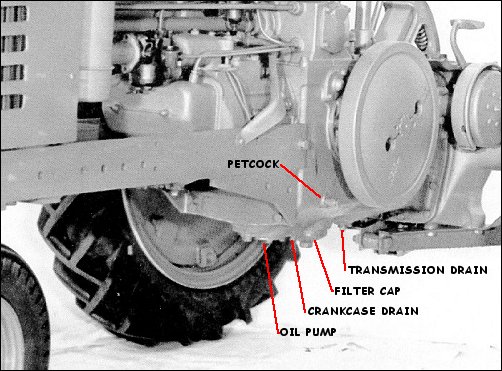Change the OIL!!!
 Sheesh!! Whose idea was it for me to wear these yellow overalls and a white t-shirt ANYWAY!!!
Sheesh!! Whose idea was it for me to wear these yellow overalls and a white t-shirt ANYWAY!!!
Once you start cleaning up your tractor, you're gonna transfer the dirt onto YOURSELF!! There's a theory that John Deere purposely designed the tractors so that they would leak oil and transmission fluid as a means of preserving the paint. Unfortunately that only works UNDERNEATH the tractor!! Anyhow.... The first thing you need to do when you get your tractor, (especially if it runs), is change the oil. You don't know HOW long that stuff has been IN there and you don't know how much water is mixed with it. You'll find a drain plug on the underside of the cylinder block. It is in between the plate that covers the oil pump and the half-dome shaped cover about 3" in diameter with a big nut in the middle that encloses the oil filter. Be prepared with a container that holds MORE than two gallons. Open the filter enclosure and change the filter, too. You can get a new one from your local John Deere dealer - part number AR26350. It is not very expensive. 
You can use the same oil you use in your car - ordinary 10W-30. Tractors are not fussy and the oils we have now are WAY better than what they had then! The new oil goes in through the breather opening up on top, on the crankcase cover. While you are at it, wash out the air filter that is under the breather cap and soak it in clean oil. On the late styled Model B there is no breather; the oil goes in through the plug on top of the big gear cover on the pulley side of the main case. The crankcase holds about seven quarts of oil. You can tell when it's full by opening the little petcock on the side of the main case. When the oil drips out, it is FULL. The petcock is located just below and in front of the crankshaft. It can be on either side of the tractor. If your tractor is a "hand-start", it'll generally be on the flywheel side. If your tractor has a starter and the flywheel is covered by a guard, the petcock will be on the pulley side. |
| If you are gonna run that tractor around, the NEXT thing you better do is change the transmission gunk. Calling it transmission "fluid" would be wishful thinking depending on how long it's been in there. In fact, you can't even be sure WHAT'S in there!! It might be mostly WATER from condensation. The transmission and the rear-end share the same cavity, but there is a drain plug under each section. After you drain all of that goop out of there, it would be a REAL good idea to fill the transmission with about 3 gallons of kerosene or diesel fuel and run the tractor around for a little bit to rinse it out. You can save the kerosene for washing parts. |
| |

The transmission/rear-end holds about four and a half gallons of 90W gear lube. You can buy that stuff at the autoparts store by the gallon or at the tractor dealer in five gallon pails. On the very back of the rear-end housing there is a slanty opening with a one inch pipe-plug in it. The illustration shows three different back covers. You can pour the fluid in through that opening. You will know it's full when it tries to overflow back out through the opening. Try not to get any of that stuff ON you; it takes FOREVER to wash off the smell. |
| |

A female mechanic named Meli Was under the tractor's belly. She pulled out the drain plug; The fluid went "glug glug". Now everyone's calling her "Smelly". |
| Oh.... I almost forgot..... If you have a hydraulic lift on the back of your tractor, it also has its own oil reservoir. It uses ordinary 30 weight motor oil too, NOT hydraulic fluid! Even if you are not going to use the hydraulic unit, keep it full of oil because whenever the PTO shaft turns, the hydraulic pump ALSO turns, and it needs its OWN oil to lubricate itself. Once again, the oil goes in through a "plug" somewhere near the top of the unit. When it overflows, it is full. |
Go back to the page you just came from......